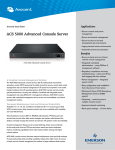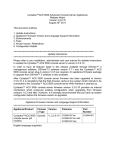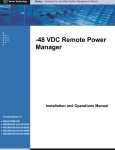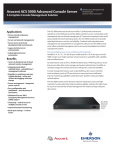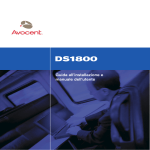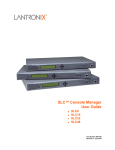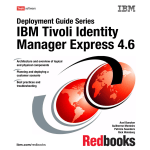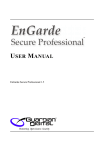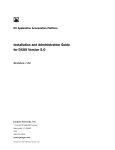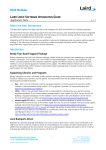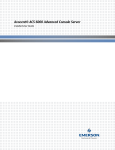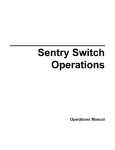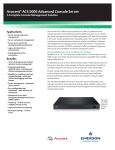Download Release Notes - Appliance
Transcript
Cyclades® ACS Advanced Console Server Appliances Release Notes Version 3.2.0 January 9, 2008 This document outlines: 1. Update Instructions 2. Appliance Firmware Version and Language Support Information 3. Enhancements 4. Fixes 5. Known Issues / Restrictions 6. Configuration Details 7. Change Log ========================================================================= Update Instructions ========================================================================= Please refer to your Installation, Administrator and User manual for detailed instructions to update the Cyclades ACS appliance to version 3.2.0. An upgrade to the Cyclades ACS plug-in for DSView® 3 management software is not required. However, some new features of the ACS appliance will not be available through DSView 3 software if the previous version of the plug-in is used. In order to have all features from ACS appliance firmware available through DSView 3 software, DSView 3 software version 3.5.1.88 and ACS plug-in version 1.3.0 for DSView 3 are required. An appliance firmware package to upgrade from DSView 3 software is also available. After ACS firmware has been upgraded to version 3.2.0, it is mandatory that the Web browser cache of any system which intends to be connected to the ACS Web interface is cleaned up. ACS firmware version 3.2.0 provides an internal mechanism which preserves existing configuration when upgrading from firmware versions 2.6.0 and later. However it is strongly recommended that you back-up system configuration before the firmware version is upgraded. ========================================================================= Appliance Firmware Version and Language Support Information ========================================================================= Appliance/Product Firmware Type Version Filename Cyclades ACS (all models) Opcode V_3.2.0 Fl0536005.bin ========================================================================= Enhancements ========================================================================= Please refer to your Installation, Administrator and User manual for a detailed list of features supported by Cyclades ACS version 3.2.0. Major features of Cyclades ACS 3.2.0 include: I. Dual Stack support with IPv4 & IPv6 - One of the major enhancements made in Cyclades ACS 3.2.0 is the IPv6 support. Both IPv4 and IPv6 protocols are concurrently supported. As a result of this addition, a few other enhancements were added which are listed below: 1. ICMPv6 support. 2. DHCPv6 support: Ethernet IPv6 addresses can be dynamically assigned by a DHCPV6 server. 3. Stateless auto-configuration support. 4. The following remote authentication services support IPv6: o DSView o RADIUS o TACACS+ o LDAP o Kerberos 5. Serial interfaces can be configured with IPV6 addresses (port IP alias). 6. PPP interfaces can be configured or dynamically assigned with IPv6 addresses. This refers to serial ports with external modems and PCMCIA analog modem cards using the PPP protocol. PCMCIA ISDN cards do not support IPv6. 7. The following networking services can be configured to support IPV6 protocol: a. Access to DNS Servers b. Sending messages to Syslog Servers c. SNMP d. Sending SNMP Trap e. Remote Authentication (see item 4 for further details) f. Access to Hosts g. Stateful and stateless packet filtering (firewall) h. Static Routes i. Sending messages/events to SMTP Servers j. Sending data to Data Buffering Servers k. Access to NTP Server l. FTP (file transfer) for Configuration Backup m. FTP (file transfer) for Firmware upgrade 8. ACS MIB (Management Information Base) and ACS Trap MIB (Management Information Base) were extended to add IPV6 information. II. Linux® kernel upgrade: upgraded the Linux kernel from version 2.6.11.12 to version 2.6.22.1 and enabled IPv6 support. III. Security Breaches covered by OpenSSL package upgrade a. Upgraded the OpenSSL package from version 0.9.8d to 0.9.8g. IV. Outlets and IPDU names: implemented support for dash character (‘-‘) for outlet and IPDU names, in addition to alphanumeric and underscore (‘_’). V. Support for ServerTech power units model PTXL and PTXM: these power units are now supported by the ACS appliance. VI. Mindterm support: Mindterm terminal emulator version 3.1.2 is now used to launch serial port sessions using SSH or telnet protocols. VII. Terminal type configuration and IBM3151 terminal support: it is now possible to configure the terminal type per serial port in the WMI and CLI. Support for IBM3151 terminal type is also included. VIII. Formatted exhibition of EMS MS-Windows Servers events: the formatted exhibition of these events is now supported during EMS serial access sessions. IX. Serial port name auto-discovery: it is possible to configure the ACS to automatically discover the name of the servers connected to the serial ports, and use this name as the serial port alias. X. Progress indication for the firmware upgrade: Web Interface and Command Line Interface display progress indication while downloading the firmware file during the firmware upgrade process. XI. NFS Data Path: NFS Data Path field length for configuration in the Web Interface has been increased to 99 characters. ========================================================================= Fixes ========================================================================= Cyclades ACS 3.2.0 release contains the following fixes: 1. The /etc/portslave/cb_script shell script file does not require manual changes anymore, when callback is performed using an external modem with Radius Remote Authentication. 2. ACS units with inserted PCMCIA modem cards would become unresponsive when “Reboot” operation was requested. User manual operation was required either ejecting the PCMCIA card or powering the ACS unit off. This has been fixed. 3. Authentication types “None”, “DSView”, “DSView/Local” and “DSView down Local” are now available options when configuring a serial port using CLI (command line interface). 4. Authentication type “Local/NIS” is now an available option when configuring PPP-PCMCIA authentication using CLI (command line interface). 5. Authentication types “NIS/Local” and “Local/NIS” for the ACS unit are now correctly saved in the Web interface. 6. Saved Menu Title is now being shown in “Applications > Terminal Profile Menu” page in the ACS Web interface. 7. User was requested to re-type the username and password when connecting to a virtual port using the Web interface – “Applications > Connect > Serial” and select a virtual port. This has been fixed where the user is not requested to re-type the credentials unless the authentication type is different. 8. Alarm notification for data buffering configuration was not being thoroughly saved in “Administration > Notifications > Notification Alarm For Data Buffering" in the ACS Web interface and also in the CLI (command line interface). This has been fixed now. 9. When the authentication type for the serial port was configured in the Wizard Mode of the ACS Web interface (“Wizard > Port Profile > Authentication type”), the authentication type to access the ACS unit was also changed. This has been fixed now. 10. “Reload Page” button has now been added to Regular User Power Management page in the ACS Web interface. 11. SNMP MIB Objects for Power Management have been restored to the ACS MIB. Access to those objects was not working as expected in firmware versions 3.1.0 and later, which has been fixed in this firmware release. 12. Remote authentication was not working properly for PPP-PCMCIA connections. This problem happens only with ACS firmware version 3.1.0-1 when the authentication type to access the ACS unit is configured to “Local”. This has been fixed now. 13. Extra characters ‘?’ and “linefeed” were shown in multiple serial sessions to the ACS ports opened through DSView software. It is fixed now. 14. The broadcast address assigned to PCMCIA Ethernet interfaces was not correct according to the configured network mask. It is fixed now. 15. ORINOCO Wireless PCMCIA card (ORINOCO 11b Client PC Gold Card - 8410-WD) is now correctly identified for further configuration through the Web and Command Line interfaces when inserted in the second PCMCIA slot. 16. Firewall configuration (iptables rules) is now being thoroughly saved in the ACS Web interface. 17. Backup and Restore Configuration files through the command line interface is now working properly. 18. Although ACS supports up to 1024 serial ports among real and virtual ports, virtual ports configuration was overwritten for larger number (more than 512) ports. This is now fixed. ========================================================================= Known Issues / Restrictions ========================================================================= Cyclades ACS 3.2.0 contains the following known issues: 1. Web browsers Netscape® 8.1 and Microsoft® Internet Explorer 7.0 are not supported to access Cyclades ACS Web interface. 2. Using ACS Web interface, whenever a new user is configured with privileges to manage the outlets of a certain server (Ports -> Physical Ports -> Modify Selected Ports -> Power Management), it is necessary to press buttons “Try Changes” or “Apply Changes” before the new user can be seen in Applications (Applications -> PMD Configuration -> Users Management). 3. Cyclades ACS v3.0.0 was the last ACS firmware version that was compatible with AlterPath® Manager (APM) v1.4.1. 4. The upgrade of the ACS firmware code may fail if the internal files are concurrently being accessed by another process or operation. If this occurs, please try firmware upgrading again until it succeeds. When the upgrade operation is performed from DSView 3 software, make sure to review the Operation Results and confirm it has finished successfully before the ACS unit can be rebooted. It is also recommended that the DSView 3 status polling is disabled while firmware upgrade is run. NOTE: Please do not reboot the ACS if the firmware upgrade operation has failed. It will render the Console Server completely inoperable and require technical assistance. 5. ACS Classic Boot Application will not be upgraded to support IPV6 protocol, which means that ACS boot configuration will not support IPV6 protocol. If firmware upgrade using IPv6 is necessary, the user can do it through FTP or scp using either WMI (Web Management Interface) or CLI (Command Line Interface). 6. IPv6 support will not be available for the following services: a. IPMI (Intelligent Power Management Interface) b. NIS Remote Authentication c. Port Virtualization (Clustering) d. NFS (Network File System) e. LPD (Line Printer Daemon) 7. IPv6 support in Dial-up Connections – ACS plug-in Version 1.3.0 for DSView 3.5.1 will not allow configuration of IPv6 addresses for dial-up connections. Communication between DSView 3.5.1 software and appliance units (including ACS) while in contingency mode (modem connection active) will be encapsulated in IPv4 over PPP (Point to point) dial connections. 8. Samba – client access to Windows File System – was removed from ACS image due to size limitations. 9. The PCMCIA commands suspend, resume and reset are not supported with Linux Kernel 2.6.22.1. 10. ACS1 does not support dial-up connections with external modems. For this application, a PCMCIA modem card is required. 11. PCMCIA Ethernet - Xircom cards only work at 10 Mbps when connected to 3Com and DLink hub/switches. 12. When the Hostname Discovery feature is enabled, the “Physical Ports” screen doesn’t automatically reflect Hostname changes in the servers connected to the ACS serial ports. It is necessary to log-out from the web interface, and then log-in again to refresh the browser cache and load the new names. 13. As DHCPv6 protocol does not provide IPv6 prefix lengths, just IPv6 addresses, there must be an IPv6 router providing advertisement messages with network prefixes to ACS when it is configured to obtain its IPv6 address from a DHCPv6 server. If the prefix is not sent by a router, ACS will become unreachable. This is a limitation of the DHCPv6 protocol. 14. When the IPv6 configuration method for the Ethernet interface is set to DHCP, DHCPv6 parameters (statefull IPv6 address, DNS server and Domain name) are accepted even if the "Managed address configuration" and "Other configuration" flags sent by the IPv6 router are not set. 15. If the authentication method is NIS, the user is advised to create an entry for user id 0 in the authentication server; otherwise many ACS applications may not work. Another option is to always use NIS/Local instead of NIS. 16. Some MS-Windows Servers events may not be correctly formatted. ========================================================================= Important Configuration Details ========================================================================= Please note the following Configuration Details for this release: 1. It is necessary to explicitly specify the local and remote IPv6 addresses when using PPP connections with IPv6, otherwise the PPP connection will not work (see your Installation, Administrator and User manual for configuration details). 2. When adding an IPv4 community (SNMP Configuration), you should actually add two communities: one of them using a normal IPv4 address, and the other using an IPv4mapped-Ipv6 address. 3. When editing file /etc/resolv.conf manually, there should be no spaces after the addresses configured for DNS servers. 4. The syntax for /etc/ssl_version.conf is: SSLVER=SSLv2 or SSLVER=SSLv3 or SSLVER=SSLv23 5. When configuring X.509 Authentication in ssh server, the file /etc/ssh/authorized_keys must allow read and write permissions. This can be done by issuing the commands below: chmod 600 /etc/ssh/authorized_keys chmod 755 / config runconfig config savetoflash 6. The option "HTTP redirects to HTTPS" is no longer available to be selected when HTTPS is disabled in “Custom” Security Profile. This change avoids the ACS unit to be unreachable through Web due to this type of misconfiguration. ========================================================================= Change Log ========================================================================= The following changes were made in this release: 1. CLI and Web interfaces were modified to support configuration of IPv6 addresses and parameters. 2. Cyclades MIB - new OIDs: a) cyEnableIPv4: used to enable or disable the configuration of IPv4 addresses. Possible values are: a. no(0), -- IPv4 addresses are disabled b. yes(1), -- IPv4 addresses are enabled b) cyEnableIPv6: used to enable or disable the configuration of IPv6 addresses. Possible values are: a. no(0), -- IPv6 addresses are disabled b. yes(1), -- IPv6 addresses are enabled c) cyIPv6Method: IPv6 configuration method. Possible values are: a. stateless-only(0) b. static(1) c. dhcp(2) d) cyDHCPv6Opts: DHCP options for IPv6. Valid values are: a. none(0) b. DNS(1) c. domain(2) d. DNS-domain(3) e) cyEthIPaddr6: IPv6 address of the Ethernet Interface. f) cyEthPrefix6: IPv6 network prefix length of the Ethernet Interface. g) cySPortRemoteIP6: default IPv6 address of the serial port. h) cySPortPrefix6: network prefix length of the port IP address. 3. Cyclades MIB – the syntax of the following objects was changed from IpAddress to DisplayString to support IPv6 addresses: cySPortAuthSrv1, cySPortAccSrv1, cySPortAuthSrv2, cySPortAccSrv2, cySPortRemHost, cyDNSpriserv, cyDNSsecserv. 4. The following packages were upgraded: a. Kerberos: from version 1.3.6 to 1.6.2 b. Linux kernel: from version 2.6.11.12 to 2.6.22.1 c. Ipsec-tools: from version 0.5-rc1 to 0.7 d. Syslog-ng: from version 1.6.8 to 2.0.5 e. Openswan: from version 2.3.0 to 2.4.9 f. Busybox: from version 1.00 to 1.7.1 g. Net-snmp: from version 5.2.1.2 to 5.3.1 h. Openssl: from version 0.9.8d to 0.9.8g 5. The following packages were included: a) b) c) d) e) f) g) h) i) j) k) l) m) n) o) glib-2.12.13 eventlog-0.2.5 sysfsutils-2.0.0 libtirpc-0.1.7 pcmciautils-014 rpcbind-0.1.4 glib-2.12.13 wide-dhcpv6-20070507 iptables-1.3.8-20070822 (iptablesV6 support) hotplug-2004_03_29 telnet-bsd-1.2 getifaddr6-2.4 iproute2-2.6.22-070710 (included only the “ip” command) netkit-ftp-2.0.4 netbsd-tftp-20020313 6. The following modules were internally modified to support IPv6: a) AIDP b) ADSAP2 c) GoAhead Web Server d) Inetd e) Pam_tacplus f) Mindterm g) Serial control modules h) rlogin i) smslink j) ntpclient k) pam_radius_auth l) OpenLDAP m) Pam_ldap n) Openssh o) netkit-bootparamd p) Event notifications modules 7. Samba – client access to Windows File System – was removed from ACS image due to size limitations.







